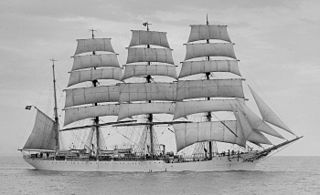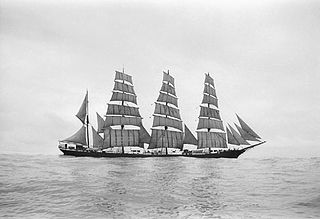This article needs additional citations for verification .(September 2020) |

The Flying P-Liners were the sailing ships of the German shipping company F. Laeisz of Hamburg.
This article needs additional citations for verification .(September 2020) |

The Flying P-Liners were the sailing ships of the German shipping company F. Laeisz of Hamburg.
The company was founded in 1824 by Ferdinand Laeisz as a hat manufacturing company. He was quite successful and distributed his hats even in South America. In 1839, he had the three-masted wooden brig Carl (named after his son) built and entered the shipping business, but lack of success made him sell the ship a short five years later.
Ferdinand's son Carl Laeisz entered the business in 1852. It was he who turned the F. Laeisz company into a shipping business. In 1857, they ordered a barque which they named Pudel (which was the nickname of Carl's wife Sophie), and from the mid-1880s on, all their ships had names starting with "P" and they became known as "the P-line". The last ship without a "P-name" was the wooden barque Henriette Behn which was stranded on the Mexican coast in 1885. [1]

The Laeisz company specialized in the South American nitrate trade. Their ships were built for speed, and they soon acquired an excellent reputation for timeliness and reliability, which gave rise to the nickname "the Flying P-Line". The five-masted barque Potosi made the voyage from Chile to England around Cape Horn in 1904 in just 57 days, a record at the time.
The Laeisz company had some of the largest sailing ships ever built. They experimented with steel-hulled five-masters, first the barque Potosi (1895) and in 1902 the huge full-rigged ship Preussen with a length of 147 metres (482 ft 3 in), 5,081 gross register tons (GRT), and over 7,800 tons deadweight (DWT). She could sail faster than 18 knots (33 km/h; 21 mph) and her best 24-hour distance was 392 sm in 1908 on her voyage to Yokohama. However, these ships turned out to be too big: their crews did not like them, and it became increasingly difficult to achieve a satisfactory utilization on the outbound leg from Europe to Chile. The later ships, such as Peking or Passat, returned to being smaller four-masted barques.
During World War I, many of Laeisz' ships were blocked in Chilean ports and had to be handed over as war reparations. However, the Laeisz company was able to re-acquire many ships after the war and put them into service again.
Towards the end of the 1920s, the company began pulling out of the nitrate trade and increasingly started transporting other goods, e.g. bananas. They also sold some of their older ships, for instance Pamir to Gustav Erikson in Finland who already had acquired the former Norddeutscher Lloyd-ship Herzogin Cecilie. The last sailing ship ordered by the Laeisz company was Padua in 1926. Subsequently, the Laeisz company only ordered steamships.


Four of the Flying P-Liners still exist today:
Other famous Flying P-Liners were a five-masted barque and a five-masted full-rigged ship (both built by Joh. C. Tecklenborg ship yard in Geestemünde)
and the four-masted barques
Other P-Line ships were:
The Laeisz shipping company still exists today, operating many freighters under traditional names.

Blohm+Voss (B+V), also written historically as Blohm & Voss, Blohm und Voß etc., is a German shipbuilding and engineering company. Founded in Hamburg in 1877 to specialise in steel-hulled ships, its most famous product was the World War II battleship Bismarck. In the 1930s, its owners established the Hamburger Flugzeugbau aircraft manufacturer which, shortly before the outbreak of World War II, adopted the name of its parent company. Following a difficult period after the war, B+V was revived, changing ownership among several owners, as Thyssen Group and Star Capital. In 2016, it became a subsidiary of Lürssen and continues to supply both the military and civilian markets. It serves two areas – new construction of warships as NVL B.V. & Co. KG, and new construction and refitting of megayachts. The company has been in operation, building ships and other large machinery, almost continuously for 146 years.

Pamir was a four-masted barque built for the German shipping company F. Laeisz. One of their famous Flying P-Liners, she was the last commercial sailing ship to round Cape Horn, in 1949. By 1957, she had been outmoded by modern bulk carriers and could not operate at a profit. Her shipping consortium's inability to finance much-needed repairs or to recruit sufficient sail-trained officers caused severe technical difficulties. On 21 September 1957, she was caught in Hurricane Carrie and sank off the Azores, with only six survivors rescued after an extensive search.

From its modern interpretations to its antecedents when maritime nations would send young naval officer candidates to sea, sail training provides an unconventional and effective way of building many useful skills on and off the water.

Iron-hulled sailing ships represented the final evolution of sailing ships at the end of the age of sail. They were built to carry bulk cargo for long distances in the nineteenth and early twentieth centuries. They were the largest of merchant sailing ships, with three to five masts and square sails, as well as other sail plans. They carried lumber, guano, grain or ore between continents. Later examples had steel hulls. They are sometimes referred to as "windjammers" or "tall ships". Several survive, variously operating as school ships, museum ships, restaurant ships, and cruise ships.

Passat is a German four-masted steel barque and one of the Flying P-Liners, the famous sailing ships of the German shipping company F. Laeisz. She is one of the last surviving windjammers.

Peking is a steel-hulled four-masted barque. A so-called Flying P-Liner of the German company F. Laeisz, it was one of the last generation of cargo-carrying iron-hulled sailing ships used in the nitrate trade and wheat trade around Cape Horn.

Pommern, formerly Mneme (1903–1908), is an iron-hulled sailing ship. It is a four-masted barque that was built in 1903 at the J. Reid & Co shipyard in Glasgow, Scotland.

Kruzenshtern or Krusenstern is a four-masted barque that was built in 1926 at Geestemünde in Bremerhaven, Germany as Padua. She was surrendered to the USSR in 1946 as war reparation and renamed after the early 19th century Baltic German explorer in Russian service, Adam Johann Krusenstern (1770–1846). She is now a Russian sail training ship.

Moshulu is a four-masted steel barque, built as Kurt by William Hamilton and Company at Port Glasgow in Scotland in 1904. The largest remaining original windjammer, she is currently a floating restaurant docked in Penn's Landing, Philadelphia, adjacent to the museum ships USS Olympia and USS Becuna.

Viking is a four-masted steel barque, built in 1906 by Burmeister & Wain in Copenhagen, Denmark. She is reported to be the biggest sailing ship ever built in Scandinavia. In the 21st century her sailing days have drawn to a close, and is now moored as botel in Gothenburg, Sweden.

Preussen (PROY-sin) was a German steel-hulled, five-masted, ship-rigged sailing ship built in 1902 for the F. Laeisz shipping company and named after the German state and kingdom of Prussia. She was the world's only ship of this class with five masts, carrying six square sails on each mast.

Potosi was a five-masted steel barque built in 1895 by Joh. C. Tecklenborg ship yard in Geestemünde, Germany, for the sailing ship company F. Laeisz as a trading vessel. Its primary purpose was as a "nitrate clipper" collecting guano in South America for use in chemical companies in Germany. As its shipping route was between Germany and Chile, it was designed to be capable of withstanding the rough weather encountered around Cape Horn.

Gustaf Adolf Mauritz Erikson was a ship-owner from Mariehamn, in the Åland islands. He was famous for the fleet of windjammers he operated to the end of his life, mainly on the grain trade from Australia to Europe.

Pisagua was a four-masted barque that was built for F. Laeisz, Hamburg, Germany in 1892 and served for twenty years, surviving a collision with Oceana in 1912. She was repaired and sold to a Norwegian owner, only to be stranded in the South Shetland Islands the following year.

Placilla was a four-masted barque which was built for F. Laeisz, Hamburg, Germany in 1892. She was sold in 1901 and renamed Optima in 1903. In 1905 she was wrecked on the Haisborough Sands.

Parma was a four-masted steel-hulled barque which was built in 1902 as Arrow for the Anglo-American Oil Co Ltd, London. In 1912 she was sold to F. Laeisz, Hamburg, Germany. During the First World War she was interned in Chile, and postwar was assigned to the United Kingdom as war reparations. She was sold back to Laiesz in 1921. She was sold in 1931 to Ruben De Cloux & Alan Villiers of Mariehamn, Finland. Following an accident in 1936, she was sold and hulked at Haifa, British Mandate of Palestine, now Israel, for two years before being scrapped.

Priwall was a four-masted steel-hulled barque with royal sails over double top and topgallant sails. The windjammer was ordered by the F. Laeisz shipping company of Hamburg and launched at the Blohm & Voss yard, Hamburg, on 23 June 1917. After delays arising from a shortage of materials during and after First World War, she was completed on 6 March 1920. Priwall was used on the nitrate trade route to the west coast of South America; she also made several voyages from South Australia’s Spencer Gulf grain ports to Europe. Her code Letters were RWLN; in 1934 they were changed to DIRQ.

Omega was a four-masted, steel-hulled barque built in Greenock, Scotland in 1887. In 1957 Omega became the last working cargo-carrying square-rigger afloat. She carried oil, guano, nitrate, wheat, and other goods. She sank in 1958, ending that age of sail.
F. Laeisz is a German shipping company with offices in Hamburg, Rostock, Bremerhaven and Grabow, Germany, as well as Japan and the Philippines.
Joh. C. Tecklenborg was a German shipbuilding company, located at the river Geeste in Bremerhaven. About 440 ships of different types, including many famous tall sailing ships were built at the yard. Founded in 1841 it was finally closed in 1928.